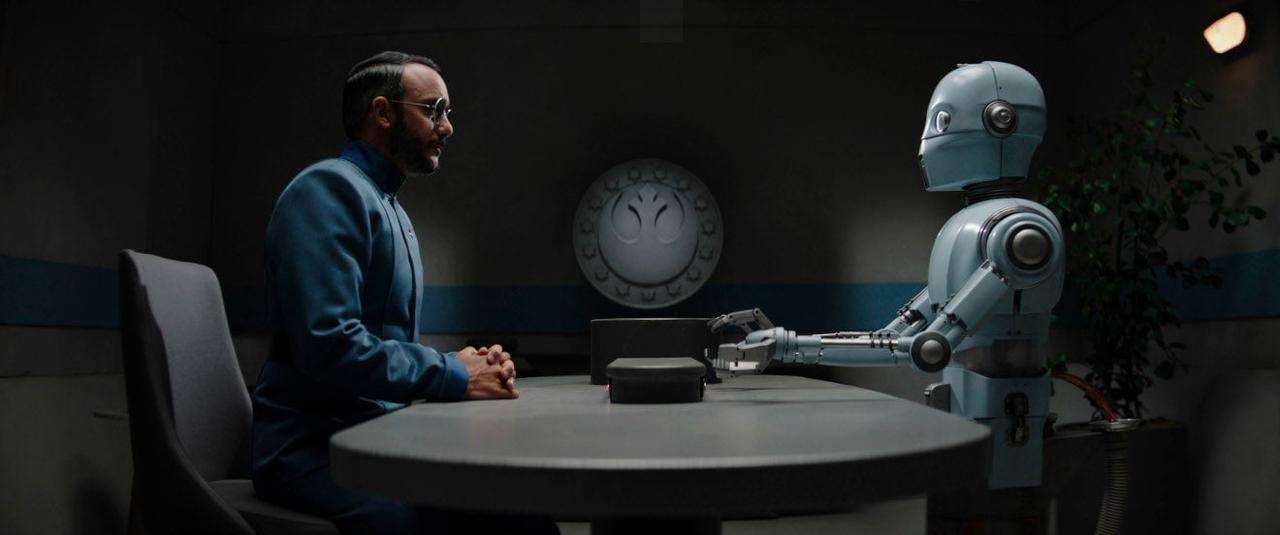If you click on a link and make a purchase we may receive a small commission. Read our editorial policy.
Latest episode of The Mandalorian reveals Star Wars' New Republic has its own Operation Paperclip
Dr. Pershing looks to redeem his past work through science.

In The Mandalorian's 'Chapter 19: The Convert' on Disney+, we pick up immediately after Din Djarin and Bo-Katan Kryze's brush with a mythical creature on their people's home planet. Though we do find out what happens next with the pair, they actually take a back seat. Instead, the episode takes place mostly on the capital planet of Coruscant focused on the recurring character Dr. Penn Pershing.
For those who don't remember, we met Pershing in the series premiere back on Nevarro. He is the Imperial scientist that extracted samples of Grogu's blood. We don't clearly know the reasons, but he did inform Moff Gideon of his failed experiments after injecting the blood into volunteers. Despite his affiliations, the doctor isn't entirely bad. He made every attempt to ensure the Child's safety and that little guy wasn't killed by Pershing's employers. Furthermore, when he was captured by Djarin and Cara Dune, he gave up vital information with regards to the defensive capabilities of Moff Gideon's light cruiser.
It's that compassion (along with a brilliant mind), that the New Republic saw the potential of Dr. Pershing to be redeemed. He could help benefit their fledgling government and society as a whole as part of their Amnesty Program. Initiates were former Imperials whose prior transgressions were overlooked and who were given a second opportunity in life.
Real life examples of something like The Mandalorian's Amnesty Program

During the tail end of the European campaign of World War II, the United States would run an analogous program. A few years before their official surrender, Germany identified brilliant scientists, engineers, and technicians within their ranks. After determining their politics and ideology, those favorable were placed on the Osenberg List, which cleared these handpicked candidates from their duties on the frontlines. They were reassigned to conduct research and develop technologies to help bolster the German defense.
U.S. Intelligence came into possession of the Osenberg List and then created their own directory of people of interest. In Project Overcast, those particular scientists would be kidnapped to disrupt development and interrogated to ascertain intel. Later, some of these high-profile targets were recruited to aid in America's postwar military research; even those who were Nazi members. The place where the scientists were being held was called Camp Overcast, and when the site became known, the initiative's name was changed to Operation Paperclip. Paperclip referred to the office item being placed on the files of individuals the U.S. wished to employ.
Between the years 1945-1959, more than 1600 German scientists, engineers, and technicians were relocated and employed by the United States. They made meaningful impacts in the fields of aeronautics, electronics, chemistry, medicine, and more. These innovations helped the country keep pace during the Cold War, but the Soviet Union had an equivalent intelligence program called Operation Osoaviakhim.
A history of Imperial defection in Star Wars

Dr. Pershing and the others in the Amnesty Program aren't the first to switch sides from the Empire. There is a long history of figures from high-ranking officers to lowly cargo pilots rethinking their allegiances. One thing they had in common is a desire to make amends for the tragedies they participated in or witnessed. Here are just a few examples.
Some of the most powerful leaders of the Rebellion were first employed by the Empire. General Jan Dodonna received his start with the Imperial Navy becoming one of the first captains of a Star Destroyer. He became disillusioned, deserted, and formed the Massassi Group. They were based out of Yavin 4 and were instrumental in the destruction of the first Death Star. Crix Madine was another general who helped destroy a Death Star. He originally was responsible for training and leading an Imperial Commando Unit, but called into question the missions he was sent on. Madine specialized in covert actions and planned the assault during the Battle of Endor
Similarly, a number of Rebel pilots were Imperial taught. Wedge Antilles and Derek 'Hobbie' Klivian were cadets enrolled at Skystrike Academy training to be elite TIE fighter pilots. After growing uncomfortable with the exceptionally cruel training exercises, Antilles reached out to the Rebel informant, Fulcrum. They were ultimately extracted by Spectres member, Sabine Wren. Likewise, Childhood friend of Luke Skywalker, Biggs Darklighter, attended Prefsbelt Fleet Camp. There he befriended an undercover Hobbie, who in turn would recruit his colleague into the Rebellion.
One major scientist who defected was Galen Erso. He was known for his expertise in crystallography and energy enrichment. That knowledge led to the development of the Death Star. Though he tried to escape the project, he was brought back in by his associate Orson Krennic. Galen reluctantly helped complete the mobile battle station but not before secretly building a weakness in a thermal exhaust port. He would send out Imperial cargo pilot Bodhi Rook to relay the message to the Rebels.
The Mandalorian's Amnesty Program Feels like parole

The Amnesty Program initially looked to be a great opportunity. Pershing's induction into the program included a public address on Coruscant where he shared his personal story of wanting to use science to benefit society as well as his shame and regret while working for the Empire. Afterwards, he was treated like a celebrity hobnobbing with the upper class and other well connected people. It really seemed as if he was really forgiven.
The doctor and other initiates into the program were given accommodations and a job to help them get back on their feet. It wasn't even limited to great scientific minds as several officers participated too. However on closer inspection, they weren't granted that much freedom.
Each member had a distinct and highly visible pin to indicate who they were. They were stripped of their names having to be referred to a designation consisting of their job, a letter, and numbers. Sure, they had a roof over their head, but they were still restricted to where they could visit and were required to stay in a designated perimeter. Finally, they had to periodically check-in with a social worker like droid who would question their mental state and feelings towards the New Republic. It doesn't feel like they were trusted since they were kept on such a short leash.
In Dr. Pershing's case, he couldn't continue his groundbreaking research. Instead he was relegated to data entry. To make matters worse, the New Republic possessed valuable Imperial technology that could be put to good use, but they would rather destroy it than keep any traces of the old regime. It looks like the purpose of the Amnesty Program is to exploit those due to their past affiliation for manual and demeaning labor. But you can't complain too much or risk being sent back to a re-integration institute or worse: hooked up to a mind flayer for rehabilitation.
Get ready for everything coming up in a galaxy far far away with our guide to upcoming Star Wars movies and TV shows.
Follow Popverse for upcoming event coverage and news
Find out how we conduct our review by reading our review policy
Let Popverse be your tour guide through the wilderness of pop culture
Sign in and let us help you find your new favorite thing.
















Comments
Want to join the discussion? Please activate your account first.
Visit Reedpop ID if you need to resend the confirmation email.